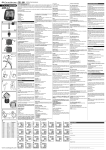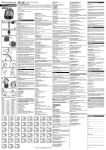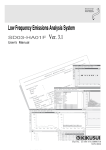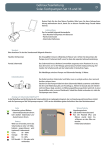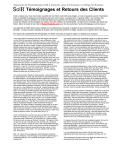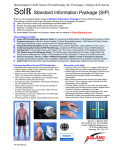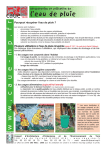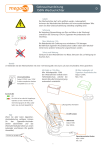Download e.GO! - User manual - SOLARC Innovative Solarprodukte GmbH
Transcript
Universal battery charger e.GO! Operating instructions and technical information 11/2008 Dear Customer, congratulations for purchasing the universal battery charger e.GO! which combines the functions of a high-quality mainsoperated device with the advantages of a solar powered, energy self-sufficient charge and supply device. We have equipped e.GO! with the latest solar cell technology, patented electronic circuits and charge regulating methods. e.GO! offers you a refined design and a top quality. SOLARC aims to create always more and more pioneering products for its everyday use for people caring about renewable energies and the environment. e.GO!, as all SOLARC products, provide you an independent and clean permanent source of energy. With an e. g. e.GO! MASTER, placed by a sunny window, you can charge up to 300 NiMH AA batteries (2000 mAh) or the same number of alkaline manganese primary batteries each year. This means, up to 33 kg of greenhouse causing CO2 gas could be prevented from emission yearly (taking average power generating CO2 emissions as source) – and even a higher quantity if we take the e.GO! PROFESSIONAL into consideration. This is just one of the e.GO!’s many advantages. In order learn more about all of e.GO!’s functions and features and to avoid any problems, we strongly recommend you to carefully read the following instructions before starting to use your e.GO! We wish you a lot of fun with your e.GO!. Overview functions and versions e.GO! is a universal battery charger with mains or solar power supply to operate and charge small electronic devices providing max. 4 watts of operating or charging (output) power. A folding case, it has 1 or 2 frontal solar modules and one rear, shaded base charging unit, in which the electronics and the battery case for 2 or 4 removable AA (also for AAAs in option) batteries or 1 to 2 Li-Ion batteries (only for the PROFESSIONAL version) are arranged. The solar modules click on a 60° position, being also possible on 45°and 30° angles to the base on which e.GO! is placed. The solar modules and the charging unit are united through a unique contact hinge connection. This enables an easy upgrade of the FUN version into a MASTER just by adding the lid module to the existing one. At the same time, both the single and the double module can be completely removed and connected with the charging unit via an optional cable adapter. This can be very useful to e. g. pack the charging unit into the backpack or a bike pannier while the solar module is simply fastened on the outside. e.GO! is of course not only suitable for its use outdoor but can also be used indoor by simply placing it by the window or just as an intelligent mains-operated battery charger. In any case, e.GO! is a convenient complement both for leisure activities (be it bike tours, hiking or climbing expeditions, boat cruises or the daily city life) and also for PROFESSIONAL purposes (for journalists, business men, tourist guides, researchers, armed forces, mountain rescue service, etc.). e.GO! is equipped with the following components for the connection with external devices (both input and output): 1 input socket for DC sources, e. g. mains adapter or additional solar modules (a serial connection of several solar modules is possible to increase the solar input power) 1 output port to supply external devices (consumer) via specific adapter cables A LED-Display consisting of 5 LEDs, indicating the capacity of the batteries and whether they are being charged or discharged 1 switch to choose the output power level Top cover solar module Battery case Output port Switch position 1 2 3 LED5 LED4 LED3 LED2 LED1 Base unit DC input socket Baffle e.GO! FUN Hinge safeguard Base solar module LED-Display e.GO! FUN and MASTER in detail 1 There are 3 different versions of e.GO!: FUN (1 polycrystalline solar module, battery case for 2 or 4 AA batteries NiMH/NiCd) MASTER (double polycrystalline solar module, battery case for 2 or 4 AA batteries NiMH/NiCd) PROFESSIONAL (double monocrystalline solar module - approx. 10% higher efficiency-, battery case for 1 to 2 Li-Ion batteries or alternatively 2 or 4 AA batteries NiMH/NiCd) e.GO! FUN (left) and e.GO! MASTER (right), respectively with mains adapter 4 V / 1 A / 4 W, master cable (output Nokia) with 3 adapter plugs (example of an accessory kit) e.GO! PROFESSIONAL with mains adapter 5 V / 1.7 A / 8 W, master cable (output Nokia) with 3 adapter plugs, UNI adapter cable with 2 adapter plugs, rubber protection, Li-Ionen battery (accessory kit example); on the right without rubber protection Short manual 1. Inserting the batteries First put batteries against the contacts, then push down. AA batteries (max. 4 piece) Li-Ion batterie (max. 2 piece) e.GO! FUN/MASTER Push gently the Li-Ion batteries into the compartment against the upper contacts until they are properly embedded. e.GO! PROFESSIONAL Note: use only batteries in accordance with Tab.1 (see below); note the correct polarity; do not use faulty or consumed batteries, insert only batteries with the same charge condition, only rechargeable batteries! 2 2. Solar powered charging and operating of external devices Adjust e.GO! in angle 30°, 45°, 60° for the best position to the sun. If LED5 (green) shines: Batteries in the e.GO! are being charged. If LED4 (red) + LED5 (green) shines: Power is being supplied to the external device (if connected). 30° 45° Note: For an optimal efficiency, please place the e.GO!’s modules completely facing the sun (choose the most adequate position angle), protecting the charging unit from it. Please avoid putting your e.GO! in the sun when closed or upside down and hence avoid over-heating of the batteries and the charging unit, which implements a high-temperature protection mechanism, disconnecting by 45°C (115°F) or more. 3. Mains-operated charging and operating of external devices Connect the mains adapter with the e.GO! via input socket. If LED5 (green) shines: Batteries in e.GO! are being charged. If LED4 (red) + LED5 (green) shines: Power is being supplied to the external device (if connected). mains adapter Note: Only use original mains adapters; mains adapters to be plugged in appropriate mains outlets (see technical data). 4. Operating an external device Adjust output power through switch (1 = 1,3 W / 2 = 2.5 W / 3 = 4.0 W), connect external device using the adequate adapter cable. If LED4 (red) shines: Power is being supplied to the external device (if connected). Note: Connect only supported external devices, follow operating notes and set (if necessary) the right polarity of the adapter cable or plug. Choose the lowest possible output power (higher efficiency). Operating an external device without buffer batteries is possible. When the operation of the external device is completed, please remove the adapter cable from the e.GO!, otherwise internal (buffer) battery consumption will occur! Avoid powerful tensile loading and bending of the cables. Do not use damaged cables (with contact problems or noticeable defects. e. g. aborted plug interlock), otherwise the external consumer device may be damaged! 5. Operating modes With AA batteries Charging mode 1 (Standard): starts automatically after inserting any batteries providing max. 1 A of charging current per battery (check charging mode 2). The charging condition display (LED1-3) shows, depending on battery type, considerable deviations. The batteries are charged 100% in every case. Charging mode 2 (-DeltaU): starts automatically after inserting completely discharged batteries, or alternatively: after complete discharge of the batteries by connection to an external device via the adapter cable after pulling the adapter cable out after disconnecting the e.GO! from the mains adapter or this one from mains (when no sun power is available) 500 mA charging current is supplied per battery string. The charging condition display (LED1-3) work like in mode 1. Charging mode 3 (Self adjustment): starts automatically after a full charge in mode 2. Exact supervision of all charging and discharging events at max. 1 A of charging current per battery (or battery string), higher precision on the charging condition display (LED1-3). After removal of the batteries, charging mode 1 or 2 will start again. 3 60° With Li-Ion batteries (only PROFESSIONAL) Same charging modes, generally max. 1 A of charging current, high precision charging condition display (LED1-3) (deviation < 20%). Trickle charge: After a complete charge of the internal batteries a transition into trickle charge (pulse charge) takes place: LED5 flashes. Stand-by (with inserted batteries): Stromspar Energy saving mode (stand-by mode) without adapter cable or mains adapter plugged in. When mains adapter or adapter cable are connected again, transition into active mode (LED display see Tab. 2). Without inserted batteries (direct operation): Direct operation of an external device by solar power or by another current source (like the mains adapter) via the DC input socket with an input cable when no batteries are inserted. Please note that when solely solar powered, output power is directly dependant on solar radiation! How to reach the highest efficiency? Ideally external devices should be connected for operation or charge when the internal batteries are full or close to full. These should then be recharged at full sun in switch position 1 (1.3 W) or when additional double module is connected, in switch position 1 or 2 (2.5 W). Table 1: Battery types and charge times Battery type, max. permitted charging current Typical capacity Charging time with mains adapter* Charging time solar* (PROFESSIONAL / MASTER) Charging time solar* (FUN) NiMH AA, 1A 1000 - 2400 mAh 1,5 – 5 hrs. 2 – 6 hrs. 4 – 12 hrs. NiCd AA, 1A 500 - 1000 mAh 1 – 2 hrs. 1 – 2,5 hrs. 2 – 5 hrs. NiMH AAA (via adapters), 1A 600 - 1000 mAh 1 – 2 hrs. 1 – 2,5 hrs. 2 – 5 hrs. RAM AA, 1A** 1500 - 2000 mAh 4 - 8 hrs. 4 - 8 hrs. 8 - 12 hrs. Li-Ion, e. g. NP120 1700 - 2000 mAh 2,5 hrs. 4 hrs. -- * for 2 AA or AAA batteries or 1 Li-Ion battery (only PROFESSIONAL); full sun implies at least 1000 W/m² and between 10 – 30°C TAmbient. Approx. Double charging time for 4 AA or AAA batteries (or 2 Li-Ion batteries) ** to be used under specific conditions, please see „Tips and notes“. Table 2: Charging condition display (LED1-3) Stand-by (flashes slowly) Active operation (blinks) Battery-charging condition LED1 LED2 LED3 LED1 LED2 LED3 0% -- -- -- -- -- -- < 20% flash -- -- flash -- -- 20 ... < 50% -- flash -- shines flash -- 50 ... < 80% -- -- flash shines shines flash 80 ... 100% flash flash flash shines shines shines 6. Install / configure / remove solar modules Pull first the middle part (hinge safeguard) out as shown below, then remove lid solar module laterally and then remove base solar module on the opposite direction. 4 Additional module with adapter cable Possible combinations for the solar operation of e.GO! : 1 or 2 solar modules connected with the base unit via hinge (standard configuration). Optional additional module connected via cable adapter to the DC input socket. Both options above combined, 1 or 2 solar modules via hinge and the optional module via cable adapter. 7. Technical data Nominal power of solar modules: 1.1 W (FUN), 2.2 W (MASTER), 2.4 W (PROFESSIONAL) Output power for operation of an external device: 1.3 / 2.5 / 4.0 W (at 5 V to 10 V output voltage and 25°C) Output voltage range: 4 ... 14 V (depending on adapter cable) Input voltage / current DC input socket: 4.5 ... 5.5 V / max. 1.8 A Charging current internal batteries: max. 1 A per battery or battery string Closed-circuit current in stand-by mode: 0.8 mA (with 2 AA batteries) Voltage range mains adapter: 90 ... 270 V AC, EN standard mains plug Ambient temperature range: 0 ... +45°C (storage), -20 ... +50°C (discharge and storage), +10 ... +30°C (recommended operating range) Max. rel. humidity: 95% Safety class: IP52 Quality standard / conformity / legal rules: CE, RoHS, EMV according to EN 55014 Case materials: PC-ABS, PMMA, Santoprene Dimensions: 160 x 90 x 36 mm Weight: approx. 210 / 300 / 420 gr. without batteries (e.GO! FUN / MASTER / PROFESSIONAL incl. rubber housing protection) 8. How to solve problems Table 3: Problems and possible remedy Symptom Possible causes Remedy Batteries not being charged after several hours in spite of connected mains adapter Soiled batteries or faulty electronics Cleaning battery contacts with contact spray or alike Exchanging batteries or getting in touch with SOLARC’s customer service for device repair Batteries not being charges after several hours in spite of fully insulated solar module Soiled battery or hinge contacts Solar module or faulty electronics Cleaning battery contacts with contact spray or alike Cleaning hinge pins with contact spray or alike Exchanging batteries or getting in touch with SOLARC’s customer service for device repair No LED shines despite attached mains adapter or fully insulated solar module and/or attached external device and/or charged batteries inserted Max. temperature range exceeded Soiled battery contacts Faulty electronics The operating temperature range must be reached (cooling down or heating up the device) Cleaning battery contacts with contact spray or alike. Getting in touch with SOLARC’s customer service for device repair. Connected consumer device cannot be charged or operated No charged batteries inserted and insufficient solar insulation Faulty contact at DC input socket or output plug adapter Faulty output or input cable Faulty electronics Inserting charged batteries or orienting the modules towards the sun (if available). Try connecting the mains adapter. If then working, faulty solar module or insufficient sun. If possible, try other plug adapter or output cable; if working, then faulty cable or adapter. If any of the components faulty, please get in touch with SOLARC’s customer service for device repair. Note: At abnormal functioning of e.GO! first remove all power sources (batteries, mains adapter) and fold solar modules, then wait at least 10 seconds and finally reconnect e.GO!. If there is no normal function then, go on as described above. 5 Tips and notes ¾ Efficiency when solar operated: The solar modules should be exactly oriented towards the sun for a maximum efficiency. ¾ ¾ ¾ ¾ ¾ ¾ ¾ ¾ ¾ ¾ ¾ e.GO!’s maximum efficiency when operating/charging an external device will be achieved when a) the batteries inserted are fully charged (ideally Li-Ion batteries, only with PROFESSIONAL possible) b) the solar radiation is approx. 50 - 100% of the maximum value (1000 W/m²: approximately midday sun in central Europe, from March until October) c) the external device is being operated in switch position 1 (1.3 watts) d) an external double module is connected and an external device is being operated in switch position 1 or 2 (1.3 or 2.5 watts) Thanks to the patented power regulation control system of e.GO!, constant output power is supplied to the attached external device even at a non-constant light irradiation. Any solar energy surplus is stored in the batteries. When the energy demand of the external device exceeds the solar energy supply, the batteries act as a buffer, counterbalancing the energy shortage. Efficiency and output power: The lower the output power of e.GO! when operating or charging external devices, the higher its degree of efficiency. Some devices need a minimum operation or charging performance as of which they accept operation or charging, though. It is therefore recommended to start in switch position 1 (1.3 watts) and to change to position 2 (2.5 watts) or 3 (4.0 watts) only when necessary. Switch position 3 should be used only in exceptions and is primarily conceived for the operation with the PROFESSIONAL’s mains adapter. Tolerance of the output power: The output power values given for the switch positions 1 to 3 are average values and depend on the ambient temperature and the output voltage: For details on possible deviations please contact our service. Discharging of external devices: Many devices consume a relatively high current internally if they are attached to an external battery charger. This pure loss of current amounts typically for 20 to 30 mA, reaching up to 80 mA for some mobile phones, and even 100 mA for some PDAs and mp3 players or alike (depending on device). A direct operation of such devices with e.GO! without an internal battery buffering should therefore only be carried out at full sunshine! Otherwise the charging current is lower than the internal consumption current of the external device and it seems as if the device is being discharged by e.GO!. Battery types: e.GO! ideally supports 1 or 2 Li-Ion batteries (only PROFESSIONAL) or 2 or 4 AA or AAA NiMH batteries with a capacity as high as possible. Regardless of their capacity and the charging mode selected, any battery type will be optimally charged thanks to the intelligent charging control. NiCd batteries should not be used in AAA form if their capacity falls below the lower limit (please see table 1). Li-Ion batteries: New Li-Ion batteries (as the new NiCd and NiMH batteries) are normally supplied uncharged and disconnected from the battery compartment. These batteries will reach their full capacity after a few charge/discharge cycles. To activate them, please charge them using the e.GO! before connecting it to any external device for operation. Li-Ion Batteries must not be shot-circuited or be exposed to water (or other liquids) or fire. They should not be exposed to heavy mechanical efforts, strongly shaken, or let fall, etc. The battery’s enclosure must not be opened or altered. Batteries which are faulty or not specified: Batteries with an internal short-circuit are charged by e.GO! only with a minimal current and can rarely recover. Therefore, if no charge condition of at least 20 - 50 % is achieved (LED2 flashes) after a charge time of several hours using the external mains adapter, the batteries should not be used any further. The use of other than the batteries mentioned in table 1, such as batteries with a lower capacity, primary batteries or other battery systems, as well as of RAM cells is not warranted. Primary batteries can however, especially in case of an emergency, be used for an exclusive discharging in e.GO!. Ruggedness and mechanical shocks: e.GO! has been designed both for indoor operation using mains power or solar (through the window) supply and for the rough outdoor operation. It therefore stands scratches and shocks similarly to other mobile devices (mobile phones, PDAs etc.). It is not, however, protected against strong mechanical shocks, such as when being dropped against a hard surface. The optional protection cover (in scope for the PROFESSIONAL version), which can be pulled out, provides a higher level of protection here. Humidity: If water penetrates into the case of e.GO!, the batteries must be taken out and (if connected) the mains adapter immediately removed. e.GO! should then be put, so that the water drains and it can dry. After drying, faultless operation should be possible again. High humidity, such as in tropical regions, should not be a problem. Temperature protection measures: e.GO! contains a series of internal protection mechanisms against very high ambient temperatures in order to prevent permanent damage of both its internal and external electronic components. If an outside temperature over 45°C is reached, the charging process will be interrupted and the device will turn off. The same can also happen by outside temperatures below the freezing point (0°C) as Batteries could be damaged otherwise. You can minimize this risk by keeping the charging unit (base) out of direct sunlight, using the solar modules to provide shade. This anyway is the optimal configuration, as it implies a correct solar orientation of the modules. Basically, operation inside heated (inside temperature above 45°C) or in other hot environment is not recommended. When switching off, all LEDs are also turned off. Short circuit and overcharge: e.GO! is protected against an external short circuit at its DC input socket as well as at the output adapter cable and switches its internal and external power supply off in this case. Such a case should be nevertheless absolutely avoided by the user and attention should be paid in order to achieve a proper functioning of attached external components. e.GO! is protected against over voltage at its inputs and outputs following EMV guidelines. Connecting a source of power at the output or the use of a non original mains adapter at the DC input or a non original adapter cable at the output can lead to damages both at e.GO! and the device attached, and is of course not warranted. This also applies when inductive loads are applied to the output adapter cable, leading to an overall emergency voltage above 16 V, which is over the 14 V upper limit and could hence induce permanent electronic damage. General safety hints: For safety and energy saving reasons, mains battery chargers (like e.GO! with mains adapter) should not be attached to unsupervised mains supply. At an internal defect e.GO! limits the output current down to a harmless value, however, an overcharging of the internal batteries cannot completely be excluded. All LEDs are turned off in such a case. 6 If an internal defect occurs, a faulty external component/device is attached, an overheating takes place, the display is turned off although charged batteries are inserted/ there is an input source of power, then immediately remove all attached devices as well as the internal batteries! Same applies if the batteries or any other components are too hot to be touched (about 70°C or more) and in case of fire or the formation of smoke. Do not touch the battery contacts or the input and/or output sockets since short circuits could take place! ¾ Care: For a faultless operation of e.GO! the following measures should be carried out regularly: Clean battery contacts, if necessary using cleaning liquid or contact spray Clean hinge contacts if visible pollution, e. g. after use in dusty surroundings Carefully remove dirt on solar modules with a soft cloth, moistened with warm water if necessary Check cables and periphery components on defects etc. Optional additional components Additional solar module (cover solar module), for e.GO! FUN Additional double solar module with DC input cable adapter. Two versions, one for e.GO! FUN / MASTER and another one for PROFESSIONAL Cable adapter to connect the lid or base solar module or both solar modules with the base unit Baffle as hinge cover for e.GO! FUN Rubber protection enclosure (standard for PROFESSIONAL) Various adapter cables (for additional information contact us or check it out at www.solarc.de) for the operation of external devices Car adapter for charging via onboard power supply (12 V) Mains adapter (2 versions 4 V / 1 A / 4 W and 5 V / 1.7 A / 8 W for e.GO! FUN / MASTER and PROFESSIONAL respectively) AAA to AA batteries’ adapter More information about further optional components and accessories online at www.solarc.de Warranty e.GO! is a high quality product developed and produced according to high technical standards. Should any defects in spite of a correct use appear, we grant a free repair or a replacement within a period of 2 years as of purchase date. The warranty does not apply: if the instructions described in this manual are not taken into consideration or a negligent use of the device and accessories takes place if non-original or recognizably faulty additional components (batteries, adapter cables, mains adapters, additional solar modules etc.) are used for external devices which were attached to e.GO! Although all devices or device series indicated in the device list (please consult our customer service or check it out online at www.solarc.de) were tested with e.GO!, we cannot guarantee a faultless charge or power supply of an external device since device manufacturers frequently change internal performance, features and functionalities. Waste disposal (only in Germany) Old and used electric devices and used batteries do not belong to the domestic waste. As a customer you are legally obliged to deliver your old electronic equipment and the batteries to the official collecting point of your city or district. You cannot put in the domestic waste all the objects listing the symbol below: Alcaline-manganese (Al Mn), Nickel-Cadmium (NiCd), Nickel-metal hydride (NiMH), Lithium-Ion (Li-Ion), Lithium-Polymer, etc.. Note for international customers: Please follow your countries legal regulations on waste disposal. SOLARC Innovative Solarprodukte GmbH Glogauer Str. 21 D - 10999 Berlin Tel.: +49 (0)30 3198554-00 Fax: +49 (0)30 3198554-99 web: email: www.solarc.de [email protected] 7







